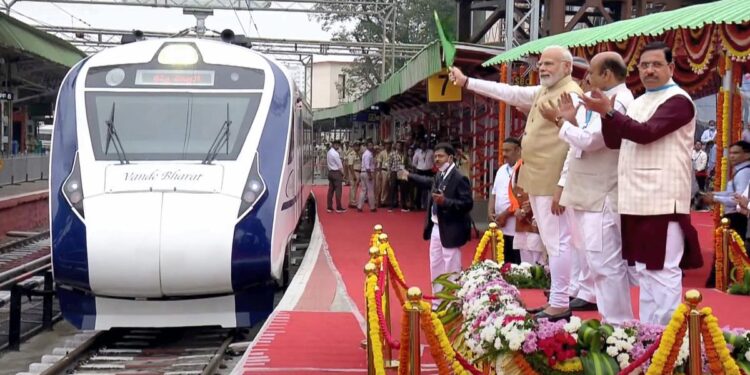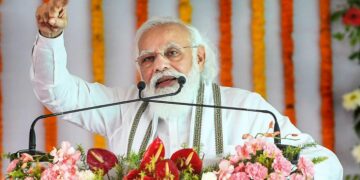
PM Modi: Prime Minister Narendra Modi today flagged off four new Vande Bharat Express trains from his parliamentary constituency, Varanasi, further expanding India’s modern semi-high-speed rail network. The newly launched trains will operate on the Banaras-Khajuraho, Lucknow-Saharanpur, Firozpur-Delhi, and Ernakulam-Bengaluru routes, significantly improving intercity connectivity and reducing travel time across states.
Addressing the public at the inauguration event, PM Modi said, “These Vande Bharat trains represent India’s progress towards a faster, cleaner, and more comfortable railway system. Trains like Vande Bharat, Namo Bharat, and Amrit Bharat are building the foundation of a new India — modern, efficient, and connected.”
The ceremony was attended by Railway Minister Ashwini Vaishnaw, Uttar Pradesh Chief Minister Yogi Adityanath, and several other dignitaries. The Prime Minister highlighted that infrastructure is the backbone of national development and that every new rail route contributes to regional economic growth.
A Step Forward in India’s Infrastructure Development
PM Modi emphasized that the Vande Bharat initiative is not just about speed but also about self-reliance and technological innovation. “Infrastructure is not limited to big bridges and highways. Every time such systems are developed, they drive the overall growth of the region,” he said.
The launch of the four new trains aligns with the government’s vision of connecting major religious, cultural, and economic centers through high-speed, comfortable, and energy-efficient rail transport.
1. Banaras–Khajuraho Vande Bharat: Linking Heritage and Spiritual Tourism
The Banaras–Khajuraho Vande Bharat Express will establish direct connectivity between some of India’s most culturally rich destinations — Varanasi, Prayagraj, Chitrakoot, and Khajuraho. The journey will be approximately two hours and forty minutes shorter than the existing special trains.
According to official sources, this train will not only promote religious and cultural tourism but also boost local economies. Travelers visiting the UNESCO World Heritage Site of Khajuraho will now enjoy a faster and more comfortable journey.
2. Lucknow–Saharanpur Vande Bharat: Empowering Uttar Pradesh’s Connectivity
The Lucknow–Saharanpur route will take around 7 hours and 45 minutes, reducing travel time by nearly one hour. The train will benefit passengers from Sitapur, Shahjahanpur, Bareilly, Moradabad, Bijnor, and Saharanpur, and improve accessibility to the holy city of Haridwar via Roorkee.
Officials said this train will enhance intercity travel in central and western Uttar Pradesh, boosting both regional trade and pilgrimage tourism. The route will also support faster access to industrial zones and educational hubs.
3. Firozpur–Delhi Vande Bharat: Strengthening the Punjab–Delhi Corridor
The Firozpur–Delhi Vande Bharat will become the fastest train on this route, covering the journey in 6 hours and 40 minutes. Connecting Delhi with major cities like Bathinda and Patiala, it will serve as a catalyst for trade, tourism, and employment opportunities in Punjab.
Officials from the Railway Ministry said the train will help integrate border regions with national markets, contributing to Punjab’s socio-economic development and strengthening business ties with the national capital.
4. Ernakulam–Bengaluru Vande Bharat: A Boost to South India’s Growth
The Ernakulam–Bengaluru Vande Bharat will complete its journey in 8 hours and 40 minutes, cutting travel time by more than two hours. It will connect key IT, education, and commercial hubs across Kerala, Tamil Nadu, and Karnataka, making travel faster and more efficient for professionals and tourists alike.
Officials stated that the route will promote interstate collaboration, drive economic growth, and foster greater tourism and cultural exchange across southern India.
PM Modi’s Vision: Fast, Safe, and Sustainable Railways
The addition of these four new Vande Bharat trains takes India’s total operational count to over 60 routes nationwide, showcasing rapid progress in rail modernization. These trains feature state-of-the-art amenities, including better seating, advanced safety systems, Wi-Fi connectivity, and energy-efficient design.
PM Modi reiterated that India’s focus is on “infrastructure for inclusion”, ensuring that development reaches every corner of the nation. He added that the Vande Bharat project is part of the government’s mission to transform Indian Railways into one of the world’s most advanced and passenger-friendly networks.
With these new trains, millions of passengers are expected to benefit from faster, cleaner, and more comfortable travel options — setting new standards in India’s transportation landscape.

















